Cultivars - A
Cultivars - B
Cultivars - C
Cultivars - D
Cultivars - E
Cultivars - F
Cultivars - G
Cultivars - H
Cultivars - I
Cultivars - J
Cultivars - K
Cultivars - L
Cultivars - M
Cultivars - N
Cultivars - O
Cultivars - P
Cultivars - QR
Cultivars - S
Cultivars - T
Cultivars - UV
Cultivars - W
Cultivars - XYZ
| |
|
QUEEN SHEBA (Shockey, 1993). OGB S. very pale orchid-violet, fading to near-white; F. very pale buff, fading to near-white, large chevron dark burgundy signal; yellow-bronze beard. Very complex pedigree. |
|
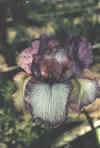 QUICK CHANGE ARTIST (McAllister, 1992) OGB- It's a novelty introduced because of its appeal to garden visitors. On opening, the white standards are veined and dotted lilac while the white falls are veined lilac with some similar dotting around the beard. In other words, typical arilbred veining. But it quickly changes to a
plicata-like pattern because the veins fade from the center of the petals as the flower ages. Registered as Eskimo Harbor X Whither Thou
Goest, but the pod parent turned out to have been mislabeled and can only be described as a white-ground
plicata. Not yet tested, but might be useful with tetraploid arils. QUICK CHANGE ARTIST (McAllister, 1992) OGB- It's a novelty introduced because of its appeal to garden visitors. On opening, the white standards are veined and dotted lilac while the white falls are veined lilac with some similar dotting around the beard. In other words, typical arilbred veining. But it quickly changes to a
plicata-like pattern because the veins fade from the center of the petals as the flower ages. Registered as Eskimo Harbor X Whither Thou
Goest, but the pod parent turned out to have been mislabeled and can only be described as a white-ground
plicata. Not yet tested, but might be useful with tetraploid arils. |
|
 QUINCINERA (McAllister, 1998) OGB+ Spanish - a special "coming of age" celebration for a girl's 15th birthday. The flower is reminiscent of a young girl's party dress, a pastel confection rarely found among the near-arils. Its white standards are marked only by a few yellow veins, while its greenish-ivory falls have veins that range from thick chocolate around the beard to faint rust at the edge. When the flower opens, the falls are also marked with an intense violet blaze in the center - but this fades as the flower ages. Werckmeister's Beauty X Whirlwind Tour. QUINCINERA (McAllister, 1998) OGB+ Spanish - a special "coming of age" celebration for a girl's 15th birthday. The flower is reminiscent of a young girl's party dress, a pastel confection rarely found among the near-arils. Its white standards are marked only by a few yellow veins, while its greenish-ivory falls have veins that range from thick chocolate around the beard to faint rust at the edge. When the flower opens, the falls are also marked with an intense violet blaze in the center - but this fades as the flower ages. Werckmeister's Beauty X Whirlwind Tour. |
|
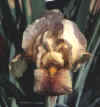 QUINTA (Rich, 1976) OGB+ Lavender standards. Yellow-beige falls with rosy-red overlay in center. Kelita Adah X
(Jallah Effendi x (I. gatesii x I. auranitica)). Pod fertile. No pollen. Has given me some striking seedlings with
halfbreds. I recommend this for anyone interested in line-breeding arilbredmedians or down-sizing
half-breds. QUINTA (Rich, 1976) OGB+ Lavender standards. Yellow-beige falls with rosy-red overlay in center. Kelita Adah X
(Jallah Effendi x (I. gatesii x I. auranitica)). Pod fertile. No pollen. Has given me some striking seedlings with
halfbreds. I recommend this for anyone interested in line-breeding arilbredmedians or down-sizing
half-breds. |
|
RADIANT SMILE (Danielson,1968). OGB+ S white; F bronze; reddish-black signal patch, bronze beard. Dardanus X Kalifa
Kashan. |
|
RAMAYANA (Rich, R. 1984) OGB S pale beige tinted orchid, veined deep orchid; copper styles. F. light beige, veined deeper, large red signal surrounded by dark red dots on very light center area; bright orange-red beard. Extremely complex pedigree. |
|
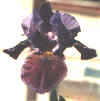 RARING TO GO (McAllister, 2000) OGB- Another double pun. The exceptionally strong plant is certainly
"rarin' to grow" and the flower has an appropriately spirited, flaring form. The standards are an iridescent, near spectrum- violet, while the falls are predominantly red-violet, enhanced by a rim of violet that matches the standards, a near-black stippled signal, and broad, bright yellow beard. It also carries a hint of ruffling that clearly sets the flower apart from those of the ½-breds. Soul Kiss X Whirlwind Romance.
Introduced this year by Pleasure Iris Gardens. RARING TO GO (McAllister, 2000) OGB- Another double pun. The exceptionally strong plant is certainly
"rarin' to grow" and the flower has an appropriately spirited, flaring form. The standards are an iridescent, near spectrum- violet, while the falls are predominantly red-violet, enhanced by a rim of violet that matches the standards, a near-black stippled signal, and broad, bright yellow beard. It also carries a hint of ruffling that clearly sets the flower apart from those of the ½-breds. Soul Kiss X Whirlwind Romance.
Introduced this year by Pleasure Iris Gardens. |
|
RAVID (Shahak, 1983). OH S light violet-blue (RHS 92D), lightly veined a little darker; F greyed yellow
(RHS 161D), lightly dotted darker, dark greyed purple signal with orange lines in center; yellow-brown beard. Judean Charmer X I. hermona. |
|
REALLY RUFFLED (Hunt-McAllister, 1988) OGB Amethyst violet standards. Cream falls heavily veined violet blending to violet flush around the edges. Heavy ruffles cover outer half of the petals. Probably Esther the Queen X (Imam Salah x Beisan Aga).Made available for any experimenters that might want ruffles on arilbreds. I prefer the tailored forms, so I haven't used it much myself. Probably the only iris Gene selected for introduction that doesn't really "speak" to me. Heavy ruffles cover the outer half of the petals, so "Really Ruffled" was the kindest thing I could say about it. |
|
 REBECCA'S VEIL (Hunt 1981) OGB+ Oyster white ground finely stippled pinkish beige. Presumably an unbalanced
tetraploid, from Lahara X Persian Pansy but partially fertile both ways with ½-breds. It produces relatively few seedlings, but the ones that survive tend to be exceptional. Gene's Guardian Angel was the first introduced. Another is a deep bluish-purple "ghost" type that glows in the dark. I introduced RV strictly for its hybridizing potential its garden value is limited because its only aril characteristics are its strong substance and
near-hoogiana-type form. New enough to be a good starting point for beginners who want to experiment a bit with the unbalanced
tetraploids. Old enough to be relatively inexpensive. Herb McKusick came up with this name. The unusual
plicata-like pattern certainly is reminiscent of a veil, but I don't know the rest of the story. REBECCA'S VEIL (Hunt 1981) OGB+ Oyster white ground finely stippled pinkish beige. Presumably an unbalanced
tetraploid, from Lahara X Persian Pansy but partially fertile both ways with ½-breds. It produces relatively few seedlings, but the ones that survive tend to be exceptional. Gene's Guardian Angel was the first introduced. Another is a deep bluish-purple "ghost" type that glows in the dark. I introduced RV strictly for its hybridizing potential its garden value is limited because its only aril characteristics are its strong substance and
near-hoogiana-type form. New enough to be a good starting point for beginners who want to experiment a bit with the unbalanced
tetraploids. Old enough to be relatively inexpensive. Herb McKusick came up with this name. The unusual
plicata-like pattern certainly is reminiscent of a veil, but I don't know the rest of the story. |
|
RECIPE FOR SUCCESS (McAllister, 1998) OGB A hybridizer's dream a pastel confection on a gardenable plant, which can be paired with
spectacular-but-less-gardenable varieties to produce seedlings with the best of both parents. Soft pinkish-violet standards, yellowish-ivory falls with a faint blush of burgundy and an area of burgundy stippling around a bright yellow beard. Boaz X Sunrise in Glory. |
|
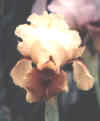 RED EARTH (Hunt-McAllister, 1992) OGB Pale greyed yellow-orange standards. Slightly darker ground of falls shows in a clear 3/8" rim around a solid overlay of red-orange. Arrow-shaped signal spot formed of brownish-black stripes. (Sojourn x Almost) X Welcome Reward. A fully fertile ½-bred that's given me many impressive offspring, mostly in shades of yellow and reddish-brown for example, #88-1-8, which is shown in the 1991 ASI Yearbook but also a burgundy-on-ivory-and-lilac seedling whose flower closely resembles those of the tetraploid ¾-breds, but whose plant is like those of the ½-breds. A carrier for pink. I was searching for a name for this one when I read an article about the annual Red Earth festival held in Oklahoma City. Aha! A perfect fit because the color of the falls is very close to that of the red clay of Oklahoma. RED EARTH (Hunt-McAllister, 1992) OGB Pale greyed yellow-orange standards. Slightly darker ground of falls shows in a clear 3/8" rim around a solid overlay of red-orange. Arrow-shaped signal spot formed of brownish-black stripes. (Sojourn x Almost) X Welcome Reward. A fully fertile ½-bred that's given me many impressive offspring, mostly in shades of yellow and reddish-brown for example, #88-1-8, which is shown in the 1991 ASI Yearbook but also a burgundy-on-ivory-and-lilac seedling whose flower closely resembles those of the tetraploid ¾-breds, but whose plant is like those of the ½-breds. A carrier for pink. I was searching for a name for this one when I read an article about the annual Red Earth festival held in Oklahoma City. Aha! A perfect fit because the color of the falls is very close to that of the red clay of Oklahoma. |
|
RED SANDS (Shockey, 1993) OGB S rose-orchid; F light buff ground with rose overlay, brown-black signal; bronze beards. Complex pedigree. |
|
REDWING'S BRAVE (McAllister, 1988) OGB Smooth violet standards, reddish purple falls. Deep purple-black lines in signal area. Heart Stealer X Mary of Magdala. I've used it for a range of "pinkish" varieties, as well reddish-violets. Not as sunfast as Mary of Magdala or Deborah's Song, but produces nice, more sunfast seedlings when paired with varieties like these. A fully fertile halfbred that I recommend to beginners. Try it with Merriglow. Someone had suggested the name "Redwing" for this one, but that name had already been used and as I thought it needed a more masculine name it evolved from "Redwing" into "Redwing's Brave". |
|
RENANA (Shahak, R. 1975). OG/OH? S pale grey ground, fine purple dots toward center, fine purple veining, thicker at base; F pale grey ground, heavily dotted with purple, darki yellow beard. The pedigree is so complex and the regelia ancestry so far back that it's highly likely that this is functionally an onco hybrid. |
|
RESURRECTION MORN (Hunt-McAllister, 1988) OGB Bright lemon yellow standards, buttercup yellow falls. Brown beard and signal. (Kalifa Baltis x Kalifa Gulnare) X Jallah Ah-Din. It gave me a fascinating pinkish-ivory quarterbred with pinkish-tan wash when I crossed it with Goddess, so I'm definitely going to experiment with it further. One of those names that appears out of the blue, that just feels right. It showed up for the first time on garden notes I took one Easter Sunday morning. It probably had something to do with the color (bright lemon yellow standards, buttercup yellow falls; brown beard and signal) but mostly to do with bloom time. |
|
RHINESTONE COWGIRL (McAllister, 1993) OGB Near-self of soft magenta-rose that looks like it has been dusted with glitter. Promising for future developments in the pinkish lines, but none of its offspring have yet bloomed. Heart Stealer X Whither Thou Goest. Judging from its pedigree, and the variation that appeared among its sibs, I expect it to also be useful in work toward veining and the pseudo-plicata pattern. "Rhinestone" came to mind to describe its sparkle. "Cowboy" followed naturally, as in the Glen Campbell song. But, cowboy? No way! This one has to be a Cowgirl! |
|
 ROAD TO DAMASCUS (Hunt, 1984) OGB Lilac standards. Greyed-yellow ground of falls is covered with maroon-black veining that blends into a metallic flush. Esther the Queen X (Kalifa Baltis x Imam Ahmid) It gives many different colors and pattern. With Pacific Gambler: an excellent quarterbred in shades of lilac and greenish-yellow. With Whirlwind Romance: a sky-blue over yellow-green with large arrow-shaped near-black signal. I recommend it highly for beginners. The colors in the flower reminded me of a favorite painting, so I thought it should have the title of the painting, as well. ROAD TO DAMASCUS (Hunt, 1984) OGB Lilac standards. Greyed-yellow ground of falls is covered with maroon-black veining that blends into a metallic flush. Esther the Queen X (Kalifa Baltis x Imam Ahmid) It gives many different colors and pattern. With Pacific Gambler: an excellent quarterbred in shades of lilac and greenish-yellow. With Whirlwind Romance: a sky-blue over yellow-green with large arrow-shaped near-black signal. I recommend it highly for beginners. The colors in the flower reminded me of a favorite painting, so I thought it should have the title of the painting, as well. |
|
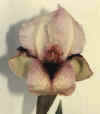 ROSE COLORED GLASSES (McAllister, 1992) OGB White-ground standards have medium violet veining that intensifies around the edges in a plicata-like pattern. Buff falls are veined with deep reddish-black. Heavy, broad near-black beard. Heart Stealer X Whither Thou Goest. Some of its seedlings show plicata-like patterns, some have heavy veining and nice signals. Veining looks near-black to the naked eye, reddish-violet through UV-filtered glasses, and near-red through sunglasses as we learned in a three-way garden debate about its color. Even iris look different when you view the world through "Rose Colored Glasses". ROSE COLORED GLASSES (McAllister, 1992) OGB White-ground standards have medium violet veining that intensifies around the edges in a plicata-like pattern. Buff falls are veined with deep reddish-black. Heavy, broad near-black beard. Heart Stealer X Whither Thou Goest. Some of its seedlings show plicata-like patterns, some have heavy veining and nice signals. Veining looks near-black to the naked eye, reddish-violet through UV-filtered glasses, and near-red through sunglasses as we learned in a three-way garden debate about its color. Even iris look different when you view the world through "Rose Colored Glasses". |
|
ROSE OF SHARON (McAllister, 1985) OGB Iridescent rose-violet standards. Dusty rose-violet falls, covered with a wash of color that starts with terracotta along the hafts and blends to almost blood-red near the black-purple beard. Martha Mia X Expert Advice. Good for a range of pinkish, pinkish-violet, and smoky tones as well as more flamboyant colors. A fully fertile ½-bred I recommend highly for beginners. While searching for a Biblical name for one of Gene Hunt's seedlings, I ran across "Rose of Sharon". I decided it would be the perfect name for one of my own introductions and, somewhat suprised that it hadn't already been used, put it on my list. The next day, I matched it with a previously selected seedling that had enough rose in it to justify the name: |
|
RUTH KEITH (McAllister, 1992) OGB- Soft blue standards, soft willow-green falls with wash of soft blue in the signal area. Sib to Gene's Little Secret X Ginger's Girl. Not tested for fertility, as this type of arilbredmedian is not expected to be fertile. Given my experience with other quarterbreds, however, I think it's worth trying with Quinta and perhaps with tetraploid arils but this is strictly for experimenters. |
|